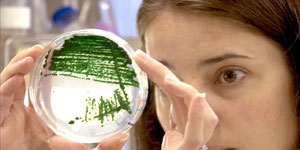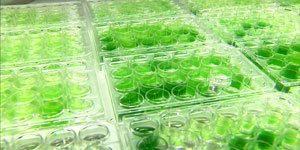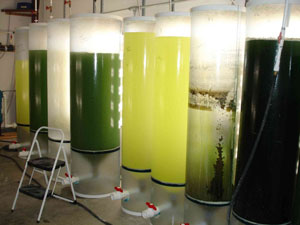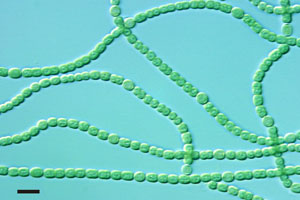Regional Partnership to Develop Algal Biofuels Gets Backing of San Diego Leaders
APRIL 28, 2009
Media Contact: Kim McDonald (858) 534-7572
Susan Brown (858) 246-0161

A researcher in Susan Golden's lab at UC San Diego examines streaks of algae
Credit: UC San Diego
San Diego Mayor Jerry Sanders today joined UC San Diego Chancellor Marye Anne Fox, local scientists and industry leaders to announce their support for a regional partnership designed to develop innovative ways to turn algae into biofuels.
Speaking at a news conference on the UC San Diego campus, Mayor Sanders and others said the San Diego region, now home to more than 500 biotechnology companies, could become a major center for renewable energy development, as scientists from UC San Diego, The Scripps Research Institute and other local research institutions join with their industry counterparts in a broad-scale research effort to develop advanced transportation fuels from algae.
These scientists recently established the San Diego Center for Algae Biotechnology, or "SD-CAB." The primary goal of the center is to create a national facility capable of developing and implementing innovative research solutions for the commercialization of fuel production from algae.
"By sharing and facilitating the interactions of these multiple researchers through this center, we hope to make sustainable algae-based fuel production and carbon dioxide abatement a reality within the next five to ten years," said Chancellor Fox. "This consortium will strengthen our ability to obtain grants and attract resources to the area. Algal biofuels will allow us to reduce our dependence on fossil fuels and other economies, and will provide opportunities for a new economy and workforce."

Cultures of algae growing in Susan Golden's lab at UC San Diego.
Credit: UC San Diego
"San Diego has a unique combination of life science research institutions, biotechnology companies and venture capital support to lead the nation in the development of this environmentally friendly source of transportation fuel," said Mayor Sanders. "As the algal biofuel industry develops, we are confident that San Diego will become a major center for renewable energy development."
This effort, which will mean more jobs and economic activity in San Diego, is already having a positive impact on the region's economy. Research on algal biofuels now employs 272 scientists and other workers in San Diego and provides nearly $16.5 million in payroll and $33 million in economic activity for the region, according to an economic assessment completed last week by the San Diego Association of Governments, or SANDAG, Service Bureau.
Direct spending on algal biofuels, combined with the additional jobs and spending in related service industries this spending generates, is currently responsible for 513 jobs, $25.4 million in wages and $63.5 million in economic output in the San Diego region, according to the SANDAG study.

Algae ponds at the research facility in the Imperial Valley near Niland.
Credit: Jim Demattia
"We are already seeing the direct and indirect benefits of algae research on the San Diego regional economy," said Lisa Bicker, President and CEO of CleanTECH San Diego, a new non-profit corporation formed to accelerate San Diego's position as a world leader in the clean energy economy. "We see it in the form of new jobs and other support for the local economy. As research and other spending on algae grows, we expect to transform what is now over $30 million in economic activity into a several billion dollar economic machine."
"The algal biofuels industry is an important addition to the existing biofuels and overall biotechnology landscape in the San Diego life science cluster, one of the most vibrant in the world," said Joseph Panetta, President and CEO of BIOCOM, a San Diego-based association of more than 575 life science companies and institutions. "This critical new component to the high wage, environmentally friendly life science industry will help increase the stability and diversity of jobs and sectors within our regional economy."
Economists say that as this industry matures and more capital is invested in algal biofuels research, jobs and economic activity are expected to be produced in many sectors of the region's economy. According to the SANDAG analysis, every $100 million of venture capital funding applied toward private sector research spending on algal biofuels would be expected to generate $15 million in economic activity and nearly $7.75 million in payroll for 100 employees in the San Diego region.

Incubation tanks at the algae farm near Niland.
Credit: Jim Demattia
In addition, the analysis concludes, the company receiving this funding and its employees would be expected to make local purchases, which combined, would generate an additional $14 million in economic activity and $4.1 million in payroll for 110 employees.
Last year, venture capitalists invested $175.9 million in the United States to develop biofuel from microalgae, according to Biofuels Digest. The industry publication said $100-million of that amount went to Sapphire Energy, a San Diego biotech company that is working to convert algae to an environmentally friendly biofuel for use in automobiles and airliners.
In the Imperial Valley, where SD-CAB scientists will grow large quantities of algae and which has one of the highest rates of unemployment in the nation, the algal biofuels effort is expected to generate additional jobs and economic activity.
"Algae and biofuels have been identified as one of the key emerging industries in the region," said Timothy Kelley, President and CEO of the Imperial Valley Economic Development Corporation. "We feel that the addition of Imperial Valley will allow the algae industry to attain full production earlier than expected. With the combination of our natural resources and available land, the Imperial Valley is the ideal location for algae as an industry."

Chains of cyanobacteria, also known as blue-green algae produce oils which could be used for transportation fuels.
Credit: James Golden
"Algae production can occur at every level in Imperial Valley from the biosciences to the production and processing of algae for bio-fuels and food products," added Kelley. "With the abundance of available land, there is a potential to take pilot projects to full-scale commercial operations. This will create jobs and diversify our economy. We welcome the production of algae in the valley, which will be compatible with our current agriculture and renewable energy production."
Algae are widely regarded by scientists as the most promising source of renewable alternative transportation fuels. They are the fastest growing organisms for turning sunlight into chemical energy and can be grown on land that will not compete with food production, as do traditional row crops such as corn when used as a biofuel source.
Microalgae, including single-celled algae and cyanobacteria, grow quickly, need relatively lower nutrient inputs and derive their energy from sunlight. They can be grown at a very large scale and take carbon dioxide from the air as part of their growth process, making carbon sequestration another beneficial by-product. Compared with crops normally used to produce vegetable oil, such as soybeans or palm, algae can generate from 10 to 50 times the amount of oil per acre.

Colonies of cyanobacteria which SD-CAB scientists are studying for their oil-production potential.
Credit: Susan Golden lab
Furthermore, local experts on algae say growing algae does not require the use of arable land required for production of food crops. Algae can be grown in salt or brackish water, so they will not adversely impact limited fresh water resources. They can be grown at very large scale, the same as agricultural crops, and because they use nutrients efficiently and can extract the nearly all the nutrients they need from wastewater, very little fertilizer is required.
"What's needed to make algae a commercially viable source of biofuel is for scientists to identify and optimize microalgae to enhance their yields and their production of biofuel," said Stephen Mayfield, an expert on the genetics of algae who is a professor at The Scripps Research Institute and associate director of SD-CAB. "That's why the basic biological research of the institutions on the Torrey Pines mesa and the collaboration with local biotechnology industries within SD-CAB is so critical to the success of this effort."
Steve Kay, dean of UC San Diego's Division of Biological Sciences and director of SD-CAB, said the critical mass of top-notch biologists at UCSD, TSRI and other research institutions that can address these problems and their close working relationship with scientists at local biotechnology companies engaged in biofuels development, make him confident that the San Diego region could become a world leader in the development of biofuels from algae.
"San Diego could well become the next Green Houston, generating not only high-paying jobs and economic activity for the region, but a new source of renewable transportation fuel for the nation to replace our dwindling supplies of oil," he said. "If we can use algae to effectively capture and sequester carbon dioxide, while at the same time producing fuel molecules, we will increase national security and at the same time help minimize the catastrophic consequences of global warming."
SD-CAB scientists are not only examining fresh-water species of algae, but those from the sea, an effort being carried out by researchers at UC San Diego's Scripps Institution of Oceanography.
"Scripps Institution of Oceanography and UC San Diego have demonstrated leadership in identifying solutions for the planet's environmental challenges," said Tony Haymet, Director of Scripps and UCSD's Vice Chancellor for Marine Sciences. "Scripps Oceanography's research knowledge and expertise in the marine environment is providing a platform for developing algae as a renewable biofuel and economic driver for the future."
By involving students in research activities at local research institutions, such as UC San Diego, SD-CAB researchers say they also intend to train a new generation of scientists for careers in entirely new occupations such as biofuels development that are likely to flourish in future years.
"SD-CAB will train young scientists, educate the public and facilitate discussion and collaboration with regional, state and national policy makers about the potential of algae for energy independence and conservation," said Kay.
Related Links- SD-CAB website
- Video and B-roll FTP site
